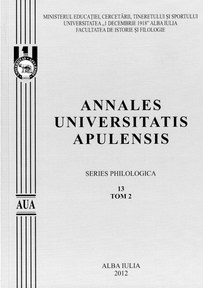ROMANELE LUI CAMIL PETRESCU – APLICAŢII NARATIVE ŞI STILISTICE
Camil Petrescu’s Novels – Narrative and Stylistic Approaches
Author(s): Cristian Arhip, Odette ArhipSubject(s): Literary Texts
Published by: Universitatea »1 Decembrie 1918« Alba Iulia
Keywords: narrative; stylistics; Camil Petrescu; hyberbaton; metonymy; archetype
Summary/Abstract: Both well-known Camil Petrescu’s novels (“Ultima noapte de dragoste, întâia noapte de război” and especially „Patul lui Procust”) are very generous for all kinds of approaches. We do not insist upon traditional references to the French authors’s works such as M. Proust, Stendhal, A. Gide, ect. which bred a true exegesis-inflation in the past. Identifying in our several previous contributions remarcable resemblances with famous and valuable international and Romanian masterworks, we attest in this paper some narrative and stylistic pleas. We offer another perspective upon these novels, as symbolic or mythical elements alluding to archetypal fields like Hamlet, Don Quixote, Mesterul Manole or Mihai Eminescu can be traced. Taking into account this outlook, the analysis is not content with the general presentation of a multiple-stage text. Its characteristic figures are: Gedanken-Hyberbaton, ergon, metaphor, metonymy. We notice also a visual dialogue between the spaces and a duality of the narrative perspective, the latter setting up a special communication between the narrative field and the commentary one. The ambivalence and the author’s split personality are obvious, but we highlight a strong antithesis between sacral parts of the novel (the main text as a background) and the secular parts, which are the ample footnotes. The footnotes act like a kind of a frame giving the impression of a world with three dimensions. The novels-structure hinting to hyberbaton attains to tectonic features very similar to those of the architectural piece of works or to paintings. This is a groundbreaking characteristic and we offer it a significant part of this contribution. We also focus on the stylistic distinctions between the different “authors”: dna T, Fred Vasilescu, G. D. Ladima, and the stated author. Conclusively, the narrative and stylistic analysis aims to argue for the mythical and archetypal features and traces we had found out (referring to Hamlet, Don Quixote, Mihai Eminescu and the hero of the popular ballad “Mesterul Manole”).
Journal: Annales Universitatis Apulensis. Series Philologica
- Issue Year: 13/2012
- Issue No: 1
- Page Range: 7-36
- Page Count: 30
- Language: Romanian

